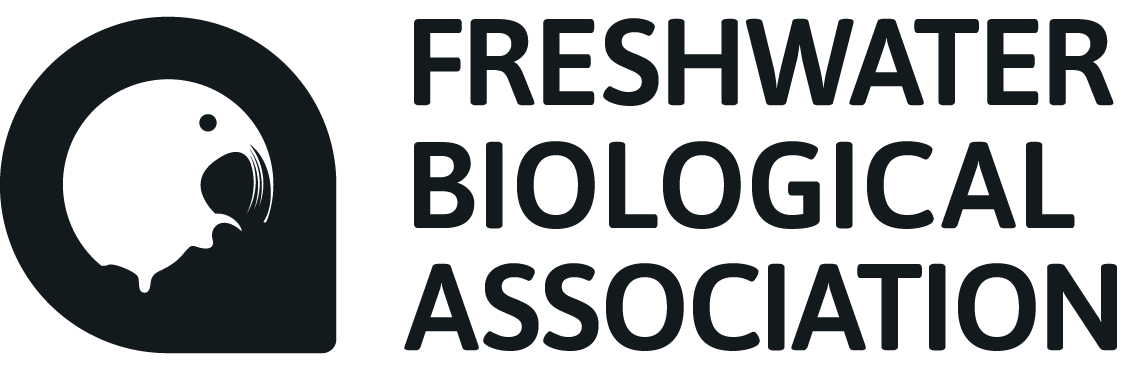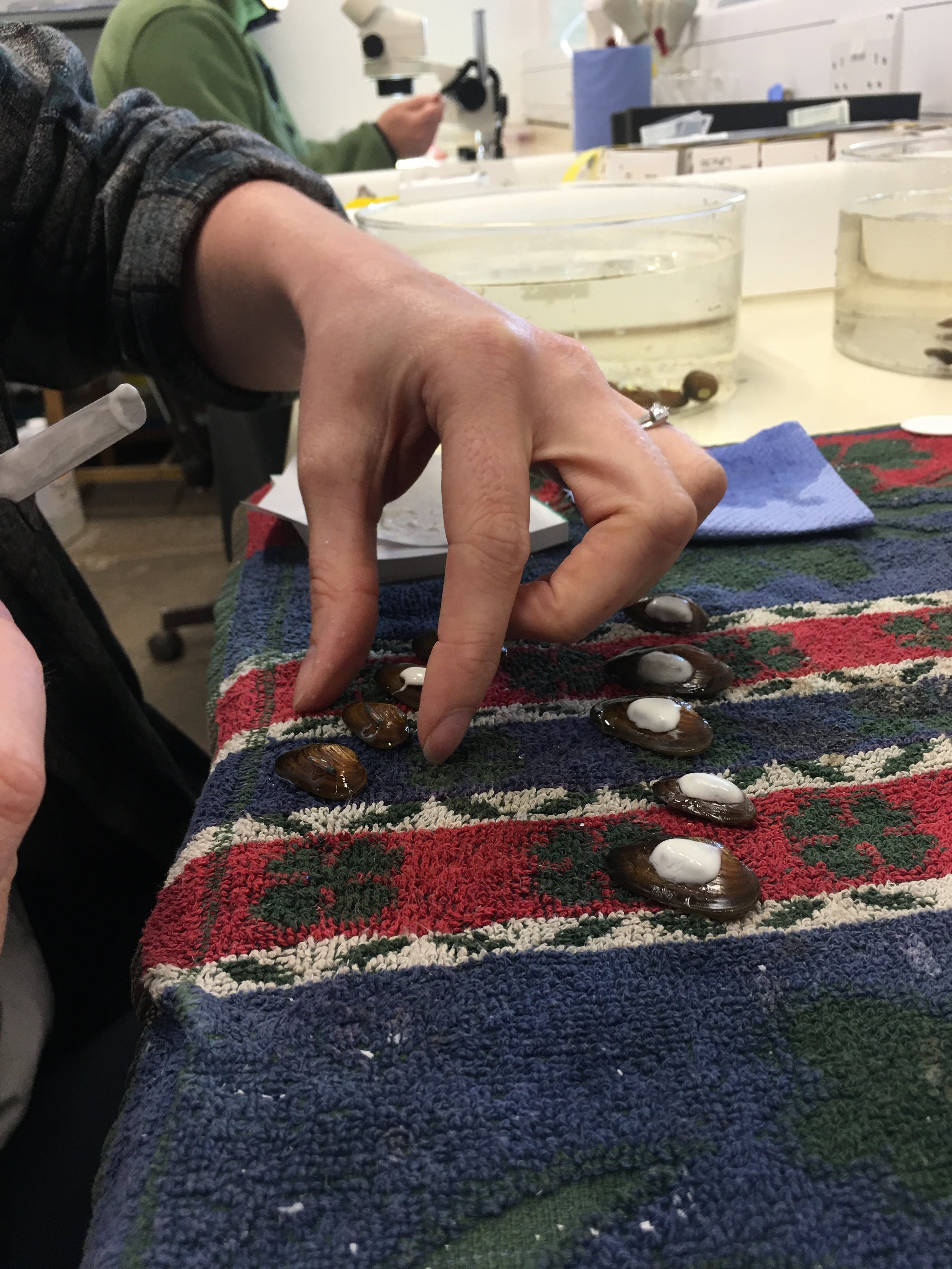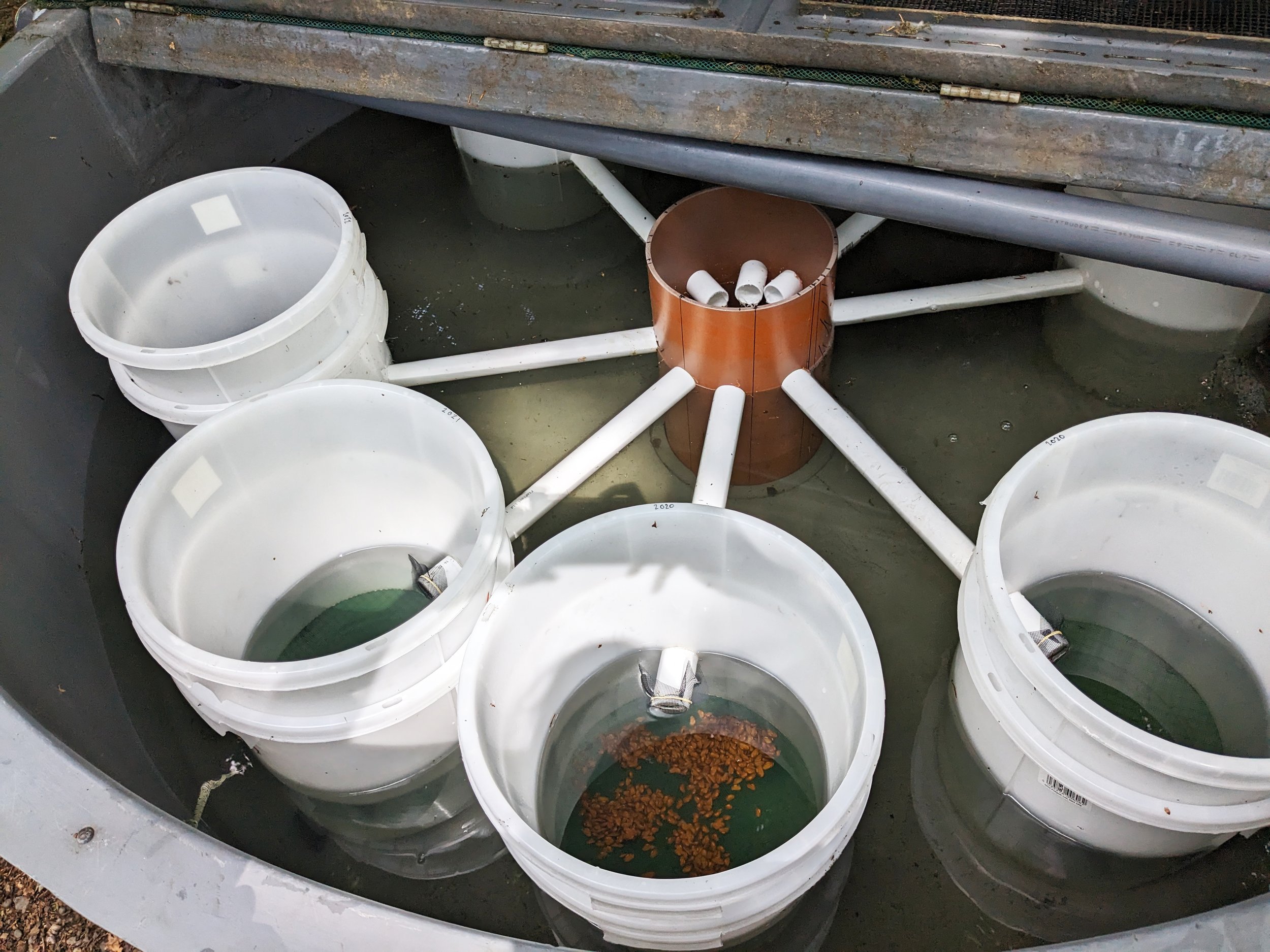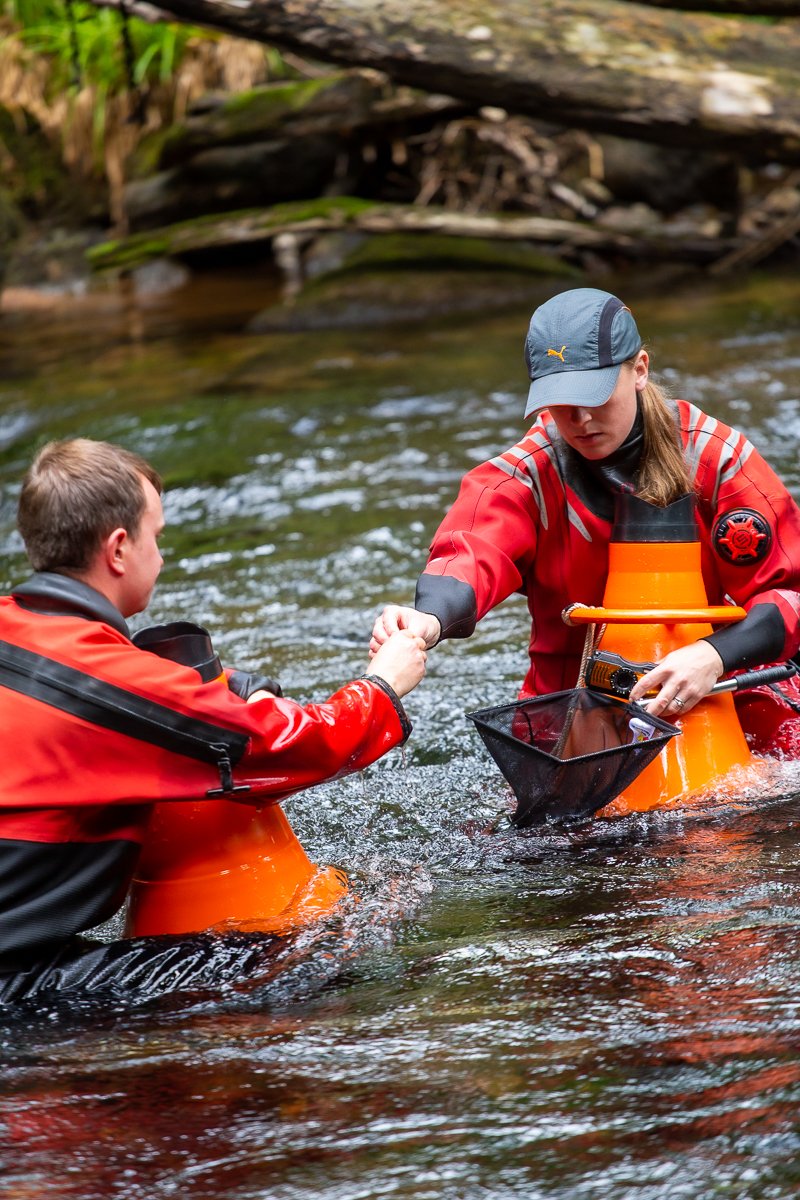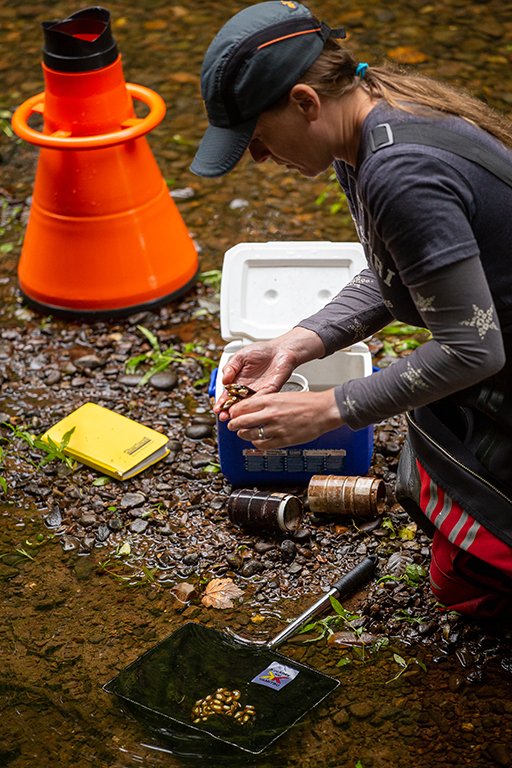Freshwater pearl mussels included in new Natural England publication
9 October, 2023
The Freshwater Biological Association is thrilled to have contributed information about our work on the freshwater pearl mussel in Natural England’s newly published selection of case studies.
On 27 September 2023, Natural England published a selection of case studies, titled: Reintroductions and Conservation Translocations: Case studies from the UK Volume 1 NERR125
The Freshwater Biological Association is delighted to be included with its case study, Restoring Freshwater Mussel Rivers in England – Release of propagated freshwater mussels into the River Irt, Cumbria
The population reinforcement work described in Natural England’s document took place in 2017 and was a partnership between the FBA and West Cumbria Rivers Trust. An excerpt from the Natural England doument is below detailing our work up until early 2021.
Dr Louise Lavictoire (FBA) and Chris West (West Cumbria Rivers Trust) working on the River Irt
Restoring Freshwater Mussel Rivers in England – Release of propagated freshwater mussels into the River Irt, Cumbria
Authors: Chris West (West Cumbria Rivers Trust) & Dr Louise Lavictoire (Freshwater Biological Association).
Intervention type: reinforcement
Conservation status
IUCN Red List: Global – Endangered
Introduction
The River Irt in West Cumbria is home to a population of freshwater mussels Margaritifera margaritifera, which are in decline. Previously boasting a population of several hundred thousand individuals, their decline is in part due to habitat degradation which prevents the completion of at least one part of the complicated life cycle of the mussel. As a result, there is no evidence of recruitment over the past 60 years, which puts the population at high risk of being lost from the catchment. To prevent this from occurring, the Freshwater Biological Association (FBA), in partnership with the Environment Agency and Natural England, have been propagating mussels from the River Irt and a number of other mussel rivers in England since 2007. To complement the propagation work, efforts to restore the habitat within the catchment have been underway since 2015. In 2017, a section of the river was identified as potentially suitable for mussel releases and the first cohort of propagated individuals from the River Irt were considered to be ready for release.
Goals
Goal 1: Rear juvenile mussels in captivity.
Goal 2: Increase area of suitable habitat within catchment.
Goal 3: Release juvenile mussels into suitable habitat.
Goal 4: Refine release methodology and monitoring techniques to benefit future releases.
Success indicators
Indicator 1: Juvenile mussels reared in sufficient number to allow releases in the wild.
Indicator 2: Areas of suitable habitat within the catchment are identified and restored.
Indicator 3: Juvenile mussels persisting within the release site.
Indicator4: Revisions to release and monitoring methodologies are produced.
Project summary
Feasibility
Visual assessments of potential release sites were undertaken in 2016 throughout the catchment. Consideration was given to the amount of physical modification, adjacent land use, water quality and substrate suitability (requirements are clean but stable substrates). Observations of conditions during high and low flows were undertaken to ensure areas were suitable during all flow conditions to be expected. As a result of these investigations, the most favourable potential site was selected for further investigations of interstitial conditions, which are particularly important for juvenile mussels. Dissolved oxygen levels were assessed using specialist equipment. The assessment results concluded the site conditions were suitable to consider releasing juvenile mussels.
Implementation
Juvenile mussels of circa 33 mm in length (nine years old) were individually numbered using Hallprint tags and superglue. Mussels were transported to the reintroduction site following best practice guidelines (Killeen and Moorkens, 2016). Seventy mussels were released directly into the substrate in three patches within the site by hand placement into the substrate. No protective or enclosure systems were used. Care was taken to ensure a period of low flow was expected following the release to allow the juveniles to habituate before encountering high flows.
Post-release monitoring
Visual surveys of the release site using bathyscopes were undertaken at regular intervals as river levels allowed. Tracking of individuals was achieved using the individually numbered tags. Almost immediately after release, it was apparent that the juveniles were displaced away from the placement sites and into the wider area. Due to the size of the release site and abundance of suitable habitat this was not considered to be an issue. It is suspected that this was caused by flow displacement (likely due to movement of mobile gravels where juveniles were originally placed) rather than mussels choosing to move.
Nevertheless, juveniles continue to be found within the site three years after placement. Juveniles are typically observed in very small pockets of sandy gravel which are protected by larger cobbles and boulders. All juveniles have increased in size since release.
Major difficulties faced
This was the first release of juvenile mussels undertaken by the FBA from the rearing facility and thus little was known about how to undertake the release and how long it would take juveniles reared in captivity to habituate to the more variable water flow conditions and the different water chemistry and water quality within the catchment.
Environmental monitoring within rivers can be challenging especially when investigating the interstitial environment which requires highly specialised techniques.
Relying upon a visual count of juvenile mussels after release has been challenging. Juvenile mussels bury deeply within the substrate making visual checks difficult and thus under-counting is often a problem. Small mussels can become dislodged and visual assessment of stress is impossible. This means that on any given survey day only a low percentage of the released mussels (typically 10%) may be observed. However, by keeping records of the tag numbers encountered over time, we are confident that over a third of individuals initially released still persist within the site.
The accuracy of grid references generated by Global Positioning System (GPS) devices used as part of the post release surveys was found to be inadequate precluding its use in generating digital mapping of surveys via geographic information system (GIS) software.
Major lessons learned
Communication with other practitioners/researchers working on the same or similar projects is key. Do not be afraid to admit to struggling with an element of the project. Others working within the same field are probably experiencing the same frustrations and pooling experience and ideas can help solve the problem.
Passive Integrated Transponders (PIT) tags could have been applied to the juveniles.This technology would have assisted post-release surveying and resulted in a more accurate record of distribution throughout the site and enabled a better estimation of the success of the project. This technique is being used as part of a subsequent release research project
Success of the project
Reasons for success/failure:
Adequate assessment of release site: Habitat within the release site is considered to be in good condition and suitable for mussels as demonstrated by juveniles persisting for three years during which both high and low flows have been encountered.
Size of released individuals: the size and age of the juvenile mussels released meant that they were sufficiently robust to cope with stress of translocation and habituating to new conditions.
Monitoring and adaptive management: Monitoring juvenile persistence and movement within the site has identified where methods could be improved which will help us increase the success of future releases.
The River Irt
Project update
Since this case study was documented in 2017, the project, which continues to be a partnership between the Freshwater Biological Association and West Cumbria Rivers Trust, has since released a further 2,400 tagged juvenile freshwater pearl mussels, securing the population in the short term. The population now contains >2400 juvenile and sub-adult mussels in addition to the 300 aging adults. Captive breeding activities are ongoing at the FBA to continue augmenting this population in 2024 thanks to the Natural England Species Recovery Programme Capital Grant Scheme.
Dr Louise Lavictoire commented, “This selection of case studies really shines a light on the fantastic work being done to bring back species from the brink of extinction. We’re particularly pleased the freshwater pearl mussel was included to raise awareness of this amazing species that is hidden from view from most of the public. Our work subsequently has addressed some of the challenges we describe in the document and the use of PIT (Passive Integrated Transponder) tags has revolusionised the way we monitor release success in our project.”.
